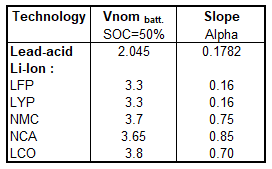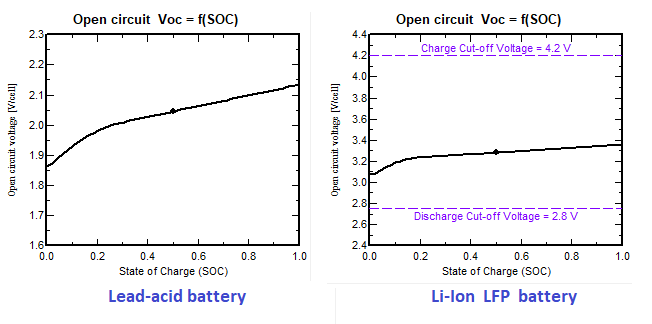Battery open-circuit voltage
Basic linear model
The battery operating voltage is based on a simple model, represented by a linear voltage evolution as function of the SOC.
$ Voc_{Batt} (SOC) = VNom_{batt} + Alpha * (SOC - 0.5)$
Where:
- VNombatt is the medium voltage of the battery, at SOC = 50%,
- Alpha is the slope, depending mainly on the technology
Nominal voltage
The nominal voltage VNomBatt and the slope of this expression is depending on the technology and the chemistry: the default values are listed below.
However these are parameters of the battery definition, which may be modified.
NB: the nominal battery voltage may sometimes be defined in a simplified way. For example, for a lead-acid battery, we always talk about 2V elements. The battery blocks are 12V, 24V, 48V. Equivalent LFP battery blocks are 13.2V (4 cells), 25,2V (8 cells) or 52.8V (16 cells), sometimes 49.5V (15 cells).
We can see that the behavior is similar for lead-acid and Li-Ion batteries.
Deep discharge correction
Now at very low SOC (below 30% for lead acid, and usually 15% for Li-Ion), we have a derate of this behavior: the voltage diminishes in a quadratic way, down to a specified minimum voltage at SOC = 0.
$ Voc_{Batt} (SOC) = Voc_{batt}Lin - DV0 * (1 - SOC/SOCThresh)² $
where:
- DV0 = additional voltage drop at SOC = 0
- SOCThresh = SOC threshold for this correction
This Voc diminution is accompanied by an increase of the internal resistance, which still enhances the voltage drop. The exact shape of this correction is of little importance for the behaviour of the system as a whole.
Temperature correction
For lead acid batteries, the battery voltage has a linear behaviour, with a diminution of about -4 to -5.5 mV/°C per element, specified on the datasheets. The battery parameters define a reference temperature, which may usually be 20°C or 25°C depending on the datasheets. \(DVbatt = muVTemp [mV/°C] * (TBattery - TBattRef)\)
NB: For correct voltage thresholds detection, good controller devices should take this linear variability into account. This requires to transmit a measurement of the battery temperature to the controller.
For Li-Ion batteries, we don't apply any voltage temperature correction. However there is a correction of the internal resistance.

